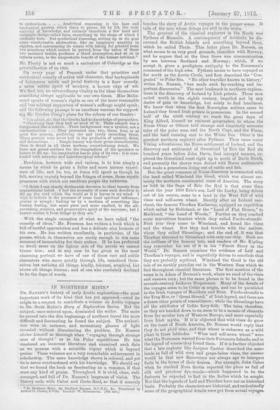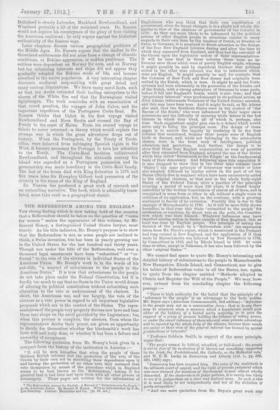IN NORTHERN MISTS.*
Da. NANSEN'S history of early Arctic exploration—the most important work of its kind that has yet appeared—owed its origin to a request to contribute a volume on Arctic voyages : to Dr. Scott Keltie's Story of Exploration Series. But the subject, once entered upon, dominated the writer. The more :be peered into the dim beginnings of northern travel the more difficult and fascinating he found the subject. The authori- ties were at variance, and momentary gleams of light revealed without illuminating the problem. Dr. Newell. shows :himself as thorough when "voyaging through strange seas of thought" as in his Polar expeditions. He has : mastered an immense literature and examined such data as we possess with a scientific vigour which is 'beyond praise. These volumes are a very remarkable achievement in scholarship. The mere knowledge shown is colossal, and yet he is never overburdened with his knowledge. We should say that we found the book as fascinating as a romance, if that were any kind of praise. Throughout it is vivid, clear, well- arranged, and full of Dr. Nausea's largeness of vision. The history ends with Cabot and Corte-Real, so that it scarcely * In Northern Mee. By Fridtjof Nansen, G.C.V.0„ &c. Translated by Arthur G. chat(); 2 Vols. Loudon : W, Lloinesannu. LSOs. not.]
touches the story of Arctic voyages in the proper sense. It tells of the men whose doings are still in the mists.
The greatest of the classical explorers in the North was Pytheas of Massalia. A contemporary of Aristotle, he dis- covered the British Islands and something beyond them, which he called Thule. This latter place Dr. Nansen, on what seems to us very good grounds, identifies with Norway, and he argues that at the time there was communication by sea between Scotland and Norway; which, if we accept it, gives a prodigious antiquity to the Norseman's command of the high seas. Pytheas seems to have voyaged as far north as the Arctic Circle, and first described the "Con- gealed" or Polar Sea. "No other traveller known to history," writes Dr. Nansen, "has made such far-reaching and im- portant discoveries." The next landmark in northern explora- tions is the discovery of Iceland by Irish priests. These men sailed north in the eighth century, impelled not by any desire of gain or knowledge, but solely to find loneliness. We know that when the first Norwegian settlers came to Iceland they found Irish priests in possession. In the second half of the ninth century we reach the great days of King Alfred, himself an eminent geographer, to whom the Norse Ottar or Othcre told strange and singularly accurate tales of the polar seas, and the North Cape, and the Finns, and the land running east to the White Sea. Otter is the greatest northern explorer after Pytheas. Then came many Viking adventurers, the Norse settlement of Iceland, and the discovery and settlement of Greenland by Erie the Red six hundred years before John Davis, that intrepid Seaman, ex- plored the Greenland coast right up to north of Davis Strait, and presently the shores were dotted with Norse settlements that made a precarious living out of cattle and fish.
But the great romance of Norse discovery is connected with the land called Wineland the Good, which was almost cer- tainly the northern continental coast of America. The story as told in the Saga of Eric the Red is that some time about the year 1000 Eric's son, Leif the Lucky, being driven out of his course, came to a land in the West full of wild vines and self-sowe wheat. Shortly after an Iceland mer- chant, the famous Thorfinn Karlsevne, equipped an expedition which sailed by Helluland, or the "Land of Flat Stones," to Markland, "the Land of Woods." Further on they reached some marvellous beaches which they called Furdu-strandir. Next year they came to Wineland, and found the vines and the wheat. But they had trouble with the natives, whom they called Skraelings ; and the end of it was that Thorfinn returned to Greenland with only one ship. Such are the outlines of the famous tale, and readers of Mr. Kipling may remember his use of it in his "Finest Story in the World." Dr: Nansen examines the evidence of Leif and Thorfinn's voyages, and is regretfully driven to conclude that they are probably mythical. Wineland the Good is the old tale of an earthly paradise out in the Western Seas which we find throughout classical literature. The first mention of the name is in Adam of Bremen's work, where we read of the vines and unsown corn ; but the same phrase is to be found in the seventh-century Isidorus Hispalensie. Many of the details of the voyages seem to be Celtic in origin, and can be paralleled in the Irish voyages of Maelduin and Bran. Furdu-strandir is the Trag Mor, or" Great Strand," of Irish legend, and there are a dozen other points of resemblance ; while the Skraelings have all the attributes of Celtic fairy-folk. The tales, therefore, as they are handed down to us, seem to be a mosaic of elements from the secular lore of Western Europe, and more especially from Irish myths. If it is objected that wild vines do grow on the coast of North America, Dr. Nansen would reply that they de not yield. wine, and that wheat is unknown as a wild plant in these latitudes. "Wino and, self-sown wheat" were what the Norsemen wanted from their Fortunate Islands, and in the legend of course they found them. If it is further objected that a late explorer like Jacques Cartier described the same lands as full of wild corn and grape-laden vines, the answer would be that new discoverers are always apt to interpret facts in the terms of their desires. For example, John Cabot when he reached Nova Scotia reported the place as full of silk and precious dye-woods—which happened to be the features he expected to find in the Indies which he sought. Not that the legends of Leif and Thorfinn have not an historical basis. Probably the characters are historical, and undoubtedly some of the geographical details were got from actual voyages.
lielluland is clearly Labrador, Maritime' Newfoundland, and Wineland probably a bit of the mainland coast. Dr. Nansen would not deprive his countrymen of the glory of first visiting the American continent; be only argues against the historical authenticity of the famous saga.
Later chapters discuss various geographical problems of the Middle Ages. Dr. Nansen argues that the decline in the Greenland settlements did not arise from a change of climatic conditions, or Eskimo aggression, or sudden pestilence. The settlers were dependent on Norway for corn, and as Norway lost her colonizing interests and ships did not appear they gradually adopted the Eskimo mode of life, and became absorbed in the native population. A very interesting chapter discusses media3val map-making with great detail and many curious illustrations. We learn many novel facts, such as that the Arabs extended their trading enterprises to the shores of the White Sea and that the Norwegians visited Spitsbergen. The work concludes with an examination of that vexed question, the voyages of John Cabot, and the important expedition of the Portuguese Corte-Real. Dr. Nansen thinks that Cabot in his first voyage visited Newfoundland and Nova Scotia and crossed the Bay of Fundy to the coast of Maine. From his second voyage he thinks he never returned—s. theory which would explain the strange way in which the great adventurer drops out of history. When the Portuguese, by the Treaty of Torde- cillas, were debarred from infringing Spanish rights in the West, it became necessary for Portugal to turn her attention to the North. The Corte-Real brethren rediscovered Newfoundland, and throughout the sixteenth century the island was regarded as a Portuguese possession and its governorship was made hereditary in the Corte-Real family, The last of the house died with King Sebastian in 1578, and five years later Sir Humpbry Gilbert took possession of the country in the name of the King of England, Dr. Nansen has produced a great work of research and an enthralling narrative. The book, which is admirably trans- lated, must take rank as a geographical classic.























































 Previous page
Previous page